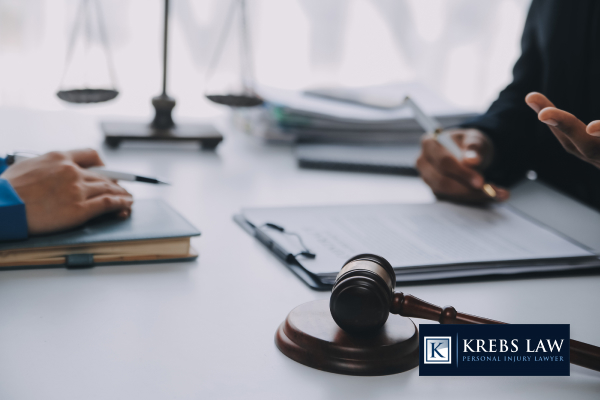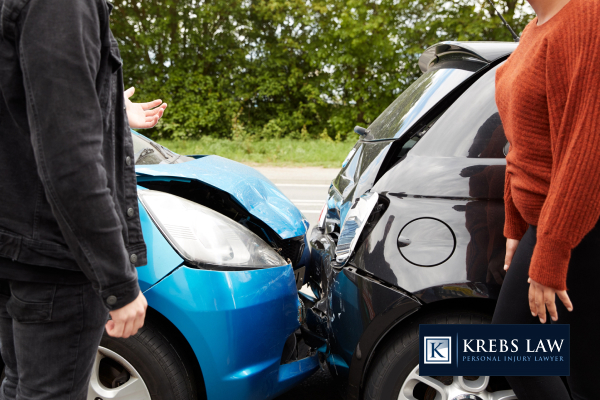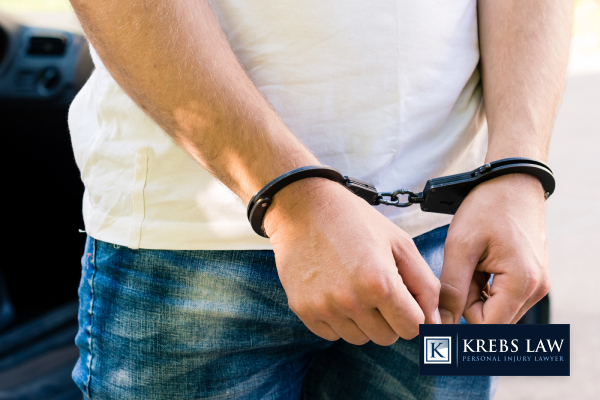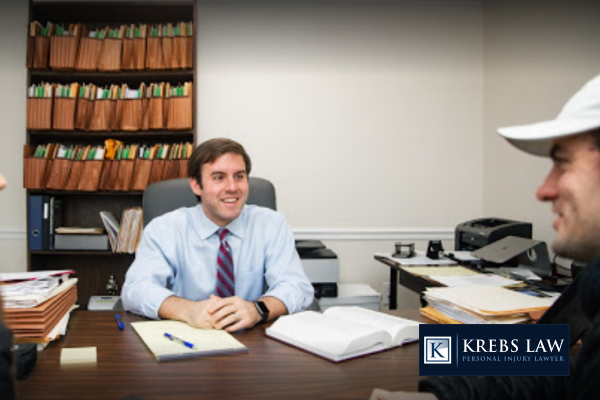This page was written, edited, reviewed & approved by JR Krebs following our comprehensive editorial guidelines. JR Krebs, the Founding Partner, has years of legal experience as a Personal Injury attorney. Our last modified date shows when this page was last reviewed.

Negligent driving is a major cause of car accidents. A driver who is careless or reckless puts others in danger. When a crash happens due to negligence, the injured party may have legal rights.
Krebs Law Personal Injury Lawyers helps victims seek compensation for injuries caused by negligent drivers. Understanding driver negligence is vital for those involved in an accident. It can determine who is responsible and what legal options are available.
Laws about driver negligence can vary by state. However, the basic idea is the same -- drivers must be careful and follow the rules of the road. If they fail to do so, they can be held legally responsible.
We will explain to you what driver negligence is, the different types of negligence, and how it affects personal injury claims.
Some drivers make mistakes that lead to accidents. Others take risks or ignore traffic laws. Understanding how driver negligence works is important. It helps injured victims know their rights and options after a crash.
Here are key details about driver negligence:
Driver negligence happens when a driver fails to act responsibly on the road. Every driver has a legal duty to follow traffic laws and drive carefully. When they don’t, they put others at risk.
Negligence can involve reckless actions, like speeding or texting while driving. It can also be a failure to act, like not stopping at a crosswalk.
If negligence leads to a crash, the injured party can file a claim. They must prove the driver did not act with reasonable care. If successful, they may receive compensation for damages.

Negligence in a car accident case is not just about a mistake. The law requires proof that a driver failed to act responsibly and caused harm. Several legal elements must be met for a successful negligence claim.
Some of the key elements needed to prove driver negligence are:
Every driver has a legal duty to drive safely and follow traffic laws. This is called the duty of care. This means that drivers must act in a way that does not put others at risk.
For example, drivers must stop at red lights, yield to pedestrians, and maintain a safe speed. If a driver ignores these responsibilities, they may be held liable for any damages caused.
If an accident occurs, the injured party must show that the driver has a duty of care. This is the first step in proving negligence.
A breach of duty happens when a driver does not act as a reasonable person would. This means they failed to follow traffic laws or drive carefully.
Some common breaches include:
If a driver’s careless actions caused the crash, they may be found negligent.
Causation links the driver’s actions to the accident. The injured party must show that the crash happened because of the driver’s negligence.
For example, if a driver runs a red light and crashes into another car, their action directly causes the accident. However, if the crash was due to a mechanical failure, the driver may not be fully at fault.
Proving causation requires strong evidence, like police reports, witness statements, or video footage.
To have a valid negligence claim, the accident must have caused damages. This can include:
Without damages, there is no valid claim. Even if a driver was negligent, there must be proof of harm for compensation to be awarded.
Negligence is not always the same in every accident case. Different types of negligence can affect how fault is determined.
Here are three main types of negligence that apply to car accidents:
Comparative negligence means that more than one party can share fault for an accident. In states that follow this rule, an injured person can still recover compensation even if they were partly at fault. However, their compensation will be reduced based on their percentage of fault.
For example, if a driver is found 20% at fault, they can still recover 80% of their damages. Some states follow a modified comparative negligence rule, meaning a driver cannot recover any compensation if they are more than 50% at fault.
Contributory negligence is a much stricter rule. In states that follow this law, an injured person cannot recover any compensation if they are even 1% at fault for the accident.
For example, if a driver was slightly speeding when another car ran a red light and hit them, they could be denied compensation under this rule.
Only a few states follow contributory negligence, but it can make proving a claim much harder for an injured driver.
Negligence can also be classified as ordinary negligence or gross negligence.
Courts treat gross negligence more harshly, and it can lead to punitive damages, which are extra penalties meant to punish the driver for extreme recklessness.

To win a negligence claim after a car accident, the injured party must provide strong evidence. Proving that a driver acted carelessly is not always simple. The right proof can make a big difference in getting compensation.
Some of the key factors that help prove negligence in a lawsuit are:
Proving driver negligence requires strong evidence. The more proof available, the stronger the claim. A police report is one of the most important pieces of evidence. It includes details about the crash, any traffic violations, and statements from both drivers. Photos and videos of the accident scene, vehicle damage, and injuries can also support the case. If there were any witnesses, their statements can confirm what happened.
Medical records help connect the injuries directly to the crash. The doctor reports hospital bills and treatment notes to show the extent of the harm caused. In some cases, cell phone records may prove a driver was distracted at the time of the crash.
If necessary, accident reconstruction experts can analyze the scene and determine how the crash happened. The more solid the evidence, the easier it is to prove the at-fault driver was negligent.
A car accident lawyer plays a key role in proving negligence. They know how to collect, analyze, and present evidence in a way that strengthens the case. An attorney starts by investigating the accident and gathering police reports, medical records, and witness statements. They may also work with accident reconstruction experts to build a stronger argument.
Insurance companies often try to deny claims or pay less than what victims deserve. A lawyer handles all negotiations, making sure the injured party gets fair compensation. If a settlement is not reached, the attorney takes the case to court.
They present evidence, cross-examine witnesses, and argue on behalf of their client. Without legal help, victims may struggle to prove negligence and recover damages. A skilled attorney protects their rights and ensures they receive the maximum possible compensation.

Drivers who act carelessly can face serious legal consequences. Depending on the severity of the accident, they may be held responsible for damages. In some cases, they may also face criminal charges. The law allows victims to seek compensation through civil claims, while severe negligence can lead to fines or even jail time. Below are the two main types of legal penalties a negligent driver may face.
Negligent drivers can be sued in a personal injury lawsuit. If found responsible, they may have to pay for damages, including medical bills, lost wages, and property damage. In some cases, victims may also receive compensation for pain and suffering.
The at-fault driver's insurance company typically covers these costs. However, if the driver is uninsured or underinsured, they may have to pay out of pocket. Courts may also award punitive damages if the driver’s behavior is reckless, such as drunk driving or excessive speeding. These extra damages serve as punishment and a warning to others.
If the negligent driver cannot pay, the victim may have difficulty collecting compensation. In such cases, lawyers help victims explore other options, such as filing claims against additional responsible parties or using their own uninsured motorist coverage.
Some cases of driver negligence go beyond civil lawsuits and lead to criminal charges. If a driver breaks the law (such as driving under the influence, reckless driving, or fleeing an accident scene), they may face criminal prosecution.
Penalties depend on the severity of the offense. Minor violations, like running a red light, may result in fines or points on a driver’s record. More serious offenses, like hit-and-run accidents or vehicular manslaughter, can lead to jail time and long-term license suspension.
Repeat offenders face even harsher penalties. Courts may impose mandatory driving courses, probation, or higher fines. A criminal conviction can also make it harder for the driver to find a job, secure loans, or maintain affordable car insurance rates. In extreme cases, their driving privileges may be revoked permanently.
A car accident attorney helps protect your rights and ensures you get fair compensation. Insurance companies often try to minimize payouts. An attorney negotiates on your behalf and gathers strong evidence to prove fault. If needed, they can file a lawsuit and represent you in court. Hiring a seasoned car accident lawyer increases your chances of getting the settlement you deserve.
Car accident victims can file a personal injury case against the at-fault driver. This allows them to recover damages like medical bills, lost wages, and pain and suffering. If the accident involved oncoming traffic or reckless driving, victims may also pursue punitive damages. In severe cases, an attorney can guide them through the civil litigation process to secure fair compensation.
It’s best to file a car accident lawsuit as soon as possible. Each state has a statute of limitations, which limits how long victims have to take legal action. If too much time passes, you may lose your right to sue. An experienced legal professional can review your case and ensure you file within the legal deadline.
Traffic accidents can result in lawsuits when there are serious injuries, high medical expenses, or disputed liability. If the at-fault driver’s insurance company refuses to pay a fair settlement, the victim may take the case to court. A lawyer helps gather police reports, medical records, and witness statements to prove negligence.
If the other driver denies fault, you will need strong evidence to support your case. This includes photos from the accident scene, dashcam footage, and witness testimony. A lawyer can also work with accident reconstruction experts to prove what really happened. If both drivers share some fault, an attorney can explain how comparative negligence laws may affect your claim.

If you were injured due to a negligent driver, you may have the right to seek compensation. Medical bills, lost wages, and other damages can add up quickly. Krebs Law Personal Injury Lawyers is committed to helping you get the financial recovery you deserve.
Our legal team understands the challenges that come with car accident claims. We handle negotiations with insurance companies and gather strong evidence to support your case. If needed, we are prepared to take your claim to court. An experienced car accident lawyer can make the legal process easier while fighting for your best interests.
We offer free consultations to discuss your case. Contact us today to learn how we can help. There are no upfront fees, and you only pay if we win your case. Call Krebs Law Personal Injury Lawyers now to schedule your consultation.

J.R. is dedicated to providing personalized representation, avoiding a one-size-fits-all approach. He tailors his strategy to the unique challenges and needs of each client and case, ensuring focused and individualized attention.
His practice mainly covers Plaintiff’s Personal Injury, including car and 18-wheeler accidents, slips and falls, dog bites, defective products, and wrongful death. He also handles commercial disputes on contingency, with experience in contracts, construction, and probate. For any dispute headed toward litigation, J.R. develops an aggressive strategy to maximize your recovery through negotiation, arbitration, or trial.


"*" indicates required fields

"*" indicates required fields